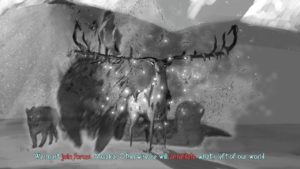
When I first heard about Mulaka, I was incredibly excited to learn about the Tarahumara people. I’ve always been interested in history and culture, and ever since games like the Assassin’s Creed series have captured the feel of their eras so well I’ve always been excited about seeing those two interests in something that isn’t a dry textbook. Mulaka is brimming with Tarahumara culture, it was obvious from my very first look at it during E3 2017. I didn’t even really know anything about the gameplay aside from it being a third person action/platformer at that point, and honestly I didn’t really care. All I wanted was to explore this culture and mythology! In fact, the developers themselves captured it in a perfectly-worded paragraph, and since there’s no way I’ll be able to capture it any better myself I’ll just share it here:
Dive into northern Mexico’s breathtaking landscapes with Mulaka, a 3D action-adventure game based on the rich indigenous culture of the Tarahumara. Renowned for their impressive running abilities, embark on the journey of a Sukurúame – a Tarahumara shaman – as you fight back the foulness corrupting the land, while drawing upon the powers of demigods. From solving puzzles in environments inspired by real Sierra Tarahumara locations, to heated hand-to-hand combat with creatures pulled from the region’s mythology, find out why the Tarahumara have earned a reputation for being superhumans.
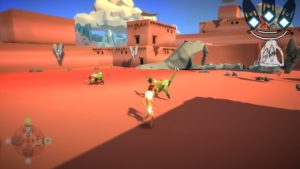
The game has an incredibly unique art style, which makes running around, thwacking enemies with your spear, jumping around climbing on things or hunting for hidden secrets feel magical. The music is also excellent, so when the developers say it’s authentic and that “many sound effects were recorded at the different locations of northern Mexico”, I absolutely believe it. In fact, the only negative I have to say about anything to do with the audio is that it gets a little annoying using your Sukurúame vision since there are times when turning it on and off over and over is necessary. The story, while light, was also quite excellent, focusing on various Tarahumara mythological creatures who aren’t typically aggressive somehow overtaken by rage and becoming dangerous. The ending of the game was particularly fantastic, and managed to reflect not only on a huge trope in gaming but also the state of our world today.
As for the gameplay, things were a bit hit and miss. The typical level involves roaming the map for three mythical stones that allow you entry to the boss. These are scattered all around each level and most require either platforming skills, fighting or both to get them. Enemies are scattered throughout the world, but there are places in which you’ll be trapped inside a dome and forced to fight multiple waves of enemies, and it’s here where things get a little tricky. Several enemies have specific ways to handle them – enemies with large shells or shields may require a fierce hit to knock them on their back before wailing on them, while others may require dodging their rushing attacks until they become vulnerable, and many can merely be attacked mercilessly without doing anything else at all. Unfortunately, dodging enemies that charge at you while others try to wail on you and flying enemies shoot stunning blasts your way can be very difficult when movement is a bit slow. You have three options to handle these situations – try to lure the quicker enemies further away and handle them first while dodging the ranged attacks, use a shield potion that makes you temporarily invincible so you can just take them on in whatever order you want while entirely safe from harm or just use your special attack to take all the enemies in an area around you out all at once! I rarely felt like a skilled fighter in the game, I instead just had to make sure I had plenty of potions and saved my special attack for particularly rough situations. The same is also true of boss fights – while they’re far more unique and it was nice to have some unique tactics required to defeat each of them, once the shield potion is unlocked you can just use one of those every so often and you’re invincible for the majority of the fight. You also have the ability to throw a spear at enemies, but at least on the Switch with the Joy-Con it was rather difficult to aim due to the high sensitivity. Holding the throw button allows you to aim and even target-locks enemies, but if an enemy moves to the side once the spear is thrown it’ll miss. These thrown spears also do about the same amount of damage as a single melee attack, so you’ll typically have to hit even the most basic enemies with 2-4 thrown spears to take them out, which was a shame since I really like throwing weapons in games.
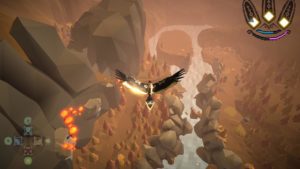
The platforming sections ranged from excellent to what I can only describe as Skyrim climbing, especially at the beginning. Until the double-jump-like ability is unlocked (which is THE COOLEST double-jump-like method of platforming I’ve seen in games where you turn into an epic bird!) you’re armed with only a single jump and running. Just like one can climb up nearly anything in Skyrim with enough patience, jumping and moving side-to-side, several platforms allow you to do the same here in Mulaka. I sometimes felt like I was cheating to get where I did, but then didn’t see any other valid method to get there anyway aside from my cheesing my way to it. Luckily it doesn’t take too long to get that jump ability, and once that happens the possibilities really open up.
As mentioned previously, the game utilizes potions. You’ll unlock four types of potions throughout the game, and you get more of them by picking various types of flowers and vegetation (even corn!). This was both very realistic and, like Horizon: Zero Dawn, a little annoying at times. You can hold up to ten of each potion at any given time, and it’s beneficial to be maxed out on them all, especially the healing potion. However, these plants don’t grow everywhere, and it takes 3-4 plants to make each potion (depending on the type), so if you get through a brutal fight and use most of them you’ll need to spend a good amount of time running around and collecting more plants. They do come back rather quickly though, so if you find a couple patches near one another you can pretty much just run back and forth over and over until you’re fully stocked back up. Also in the realistic-but-mildly-annoying category is just how you take the potions – pressing the respective directional button will drink a potion, but it takes a few seconds to watch your character drink it and do a little dance. This dance is really cool to watch, but it’s less cool to get headbutted in the middle of it and have your potion usage cancelled out. Those trapped-in-a-dome fights are particularly bad for this, and it led to the only time I died in the game – an endless, desperate loop of trying to use a potion, getting hit, getting back up, trying to use a potion, etc. in a dome. Oh, and sadly the game crashed on me when I died, meaning I had to entirely reload the game. Luckily the game auto-saved most of what I did despite there being a save spot in each level (these save spots are also very cool and fittingly-themed). Funny enough, often these save spots are near random enemies so sometimes you’ll get attacked from behind or the side when you load into an area.
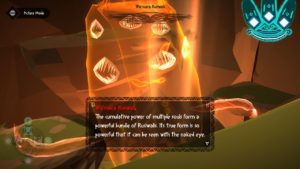
Each level in the game grants you a new ability or potion, and the developers made sure to hide things across all the levels that require various abilities. This means you’ll be backtracking to previous levels (done via fast-travel that can be used pretty much anytime), and it was one of the things I enjoyed doing throughout my time with the game. These visits back to previous levels are a perfect excuse to explore the gorgeous locations and try new things! Most of the abilities make it clear where you can use them – a powerful bear smash, for example, has a symbol on walls wherever it can be used to open new areas. These abilities are also woven into combat beautifully – a puma allows you to climb specific walls, yes, but once you’ve gained their powers you’ll also naturally do a leap as the animal when dash-attacking. It’s a little touch, but it expertly shows your character’s progression in the game. Finally, there’s a “shop” in one of the levels that allows you to turn in the currency you gain from defeating enemies and finding hidden stashes for various unlockable upgrades like more resilience or a more powerful spear.
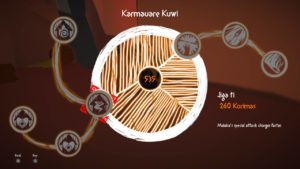
Overall, the gameplay in Mulaka isn’t bad by any means, but where the game really shines is the presentation. The audio, the graphics, the mythology, the story and even the enemies in the game are exceptional. If the game was set in a random fantasy setting I wouldn’t really be able to recommend it, but with so much love, detail and effort put into allowing the player to explore Tarahumara culture, it’s an easy recommendation to anyone that’s the least bit interested in the Tarahumara people or unique, painfully-underrepresented settings.
Note: I received a free review copy of this game for the Nintendo Switch in exchange for my honest opinion.

